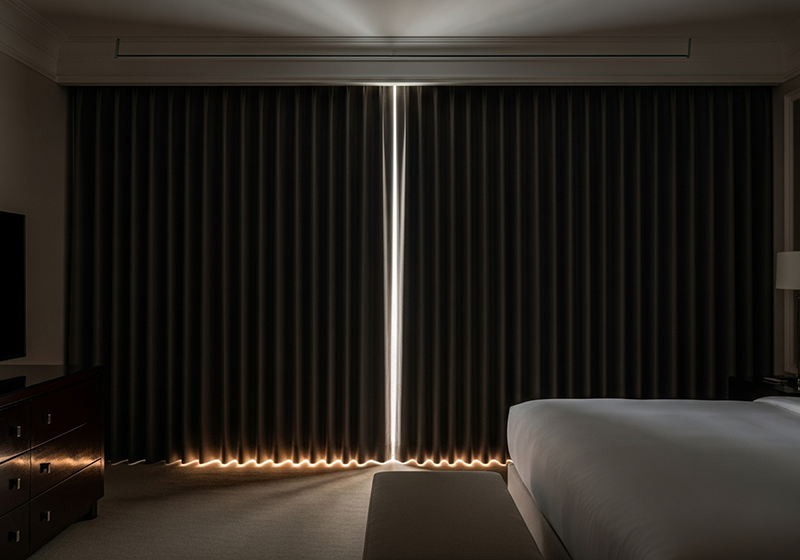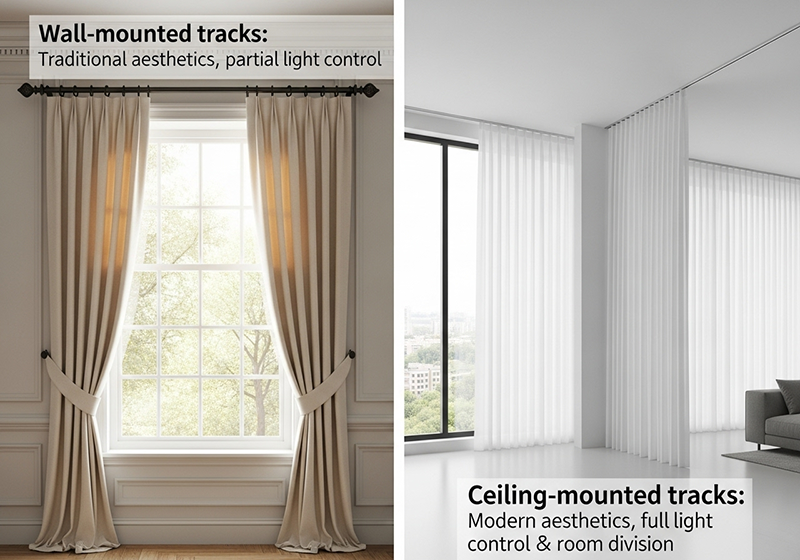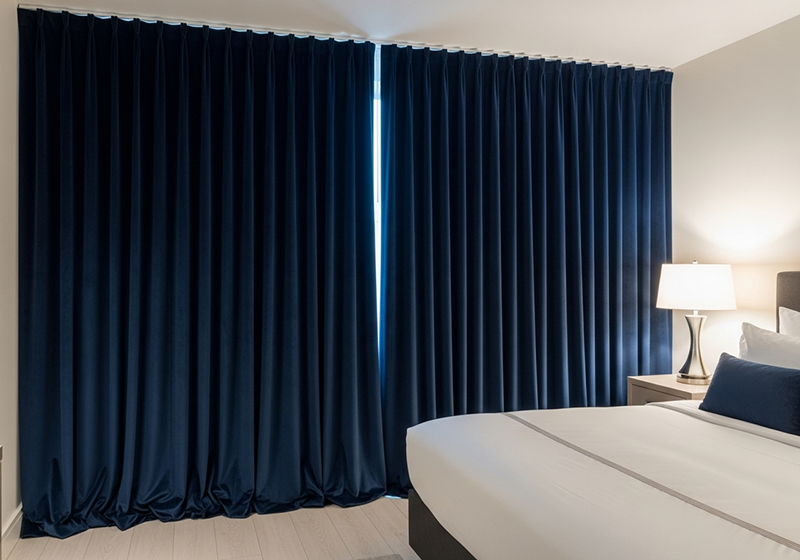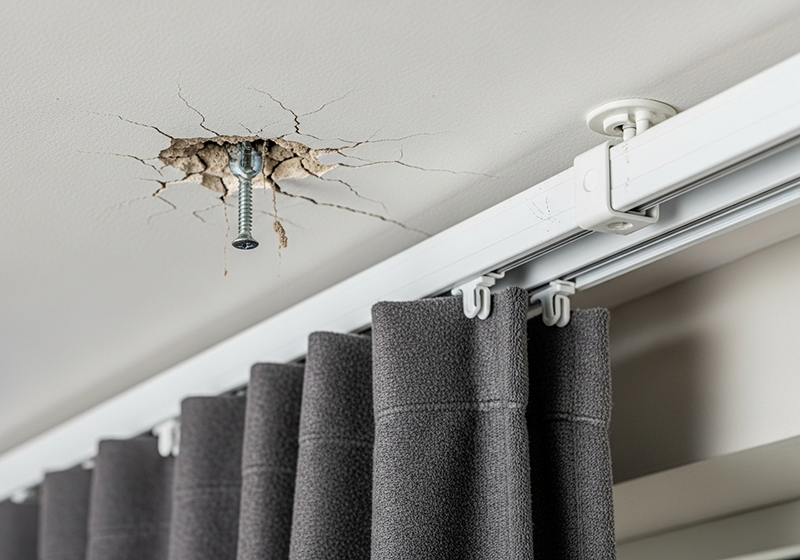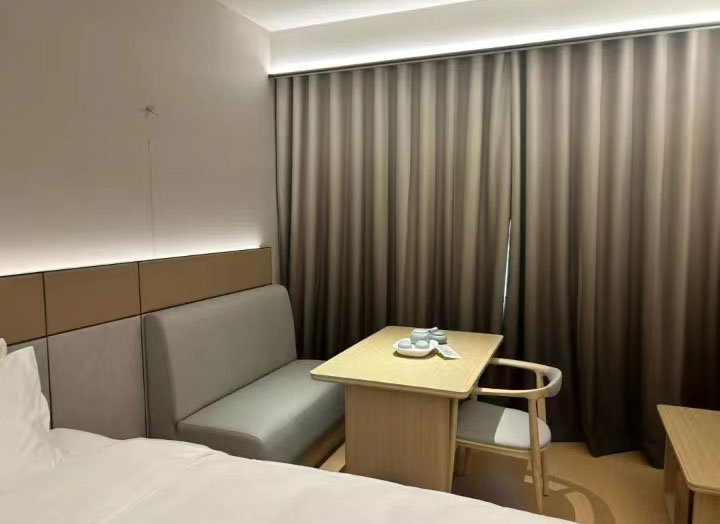Why Do Hotels Prefer Ceiling-Mounted Curtain Tracks?

Trying to give your hotel a high-end feel? Wall-mounted tracks can look dated and leak light, disturbing guests. Let's explore the solution that top hotels use.
Hotels prefer ceiling-mounted tracks because they create a seamless floor-to-ceiling drape effect that blocks light leakage from the top. This enhances guest privacy, improves sleep quality, and makes rooms appear taller and more luxurious, creating a superior guest experience.
From my very first days on the factory floor, I saw that our hospitality clients had different priorities. They weren't just buying a piece of hardware; they were investing in the guest experience. A key part of that experience is ensuring a dark, quiet room for a restful night's sleep. This is where ceiling-mounted tracks became the industry standard. My partner Matt, a Purchasing Manager for a large US brand, knows this well. He almost exclusively specs ceiling tracks for new hotel projects. Let's get into why this small detail makes such a big difference.
What is the difference between wall and ceiling curtain tracks?
Confused about mounting options? The wrong choice can ruin your room's design and function. Let’s clarify the key differences between wall and ceiling mounts for a perfect installation.
Wall-mounted tracks are attached to the wall above the window frame, which is the traditional method. Ceiling-mounted tracks are fixed directly to the ceiling, allowing for a modern, floor-to-ceiling curtain look and effective use as room dividers. The choice impacts aesthetics and light control.
I've watched countless tracks come off our production line, and the design intent for each type is very clear. Wall mounting is the classic approach. It's simple and effective as long as you have solid-headed walls above your windows to anchor the brackets securely. It gets the job done for most standard applications.
Ceiling mounting, however, is all about creating a specific look and function that designers and architects love. It allows the curtains to flow directly from the ceiling, creating a clean, seamless "waterfall" effect. This is essential in modern rooms with floor-to-ceiling glass where there's no wall space to mount a track. This method also makes rooms feel taller and more spacious. It's my go-to recommendation for achieving a premium, contemporary feel.
Here’s a quick comparison:
| Feature | Wall-Mounted Tracks | Ceiling-Mounted Tracks |
|---|---|---|
| Visual Impact | Traditional, can create a horizontal line | Modern, creates vertical lines, makes rooms feel taller |
| Installation | Requires solid wall space above the window | Attaches directly to ceiling joists or blocking |
| Best For | Standard windows with ample wall space | Floor-to-ceiling windows, room dividers, modern design |
Why use floor-to-ceiling curtains?
Do short curtains make your rooms feel small and cheap? They disrupt the visual flow. Floor-to-ceiling drapes offer a simple, elegant solution for a premium and cohesive look.
Hotels use floor-to-ceiling curtains to create an illusion of height, making rooms feel larger and more luxurious. This style provides superior light blockage and sound insulation, contributing to a better guest experience and a more polished interior design.
A ceiling track is the key that unlocks the full potential of floor-to-ceiling curtains. Together, they form a system that delivers major aesthetic and functional wins, which is critical in the competitive hospitality industry. The first thing you notice is the visual drama. Long, continuous drapes draw the eye upward, adding a sense of grandeur and making even a standard-sized room feel more spacious and elegant. It’s a powerful design tool.
But for hotels, the functional benefits are just as important. Light leakage is a top complaint from guests. A ceiling-mounted track places the curtain right against the ceiling, eliminating the gap at the top where light seeps in. When the curtain then extends all the way to the floor, it also blocks light and drafts from the bottom. This combination creates the "total blackout" effect that guests need for quality sleep. On top of that, the heavy fabric of a long curtain acts as an effective sound buffer and thermal insulator, helping to block out street noise and regulate room temperature. It's a complete solution for guest comfort.
What are common problems with ceiling tracks?
Worried about installing ceiling tracks? A poor installation or the wrong product can lead to sagging tracks, property damage, and safety hazards, which is a nightmare for any hotel owner.
Common problems include improper anchoring, leading to failure under load, especially in plasterboard ceilings. Other issues are selecting a track that cannot support the curtain's weight, causing it to bend, and complex installations requiring professional skills to ensure safety and stability.
A ceiling track is only as strong as its installation. This is the most critical point I stress to all my partners. Unlike a wall, a ceiling might not have support exactly where you need it. You can't just drive screws into plasterboard and hope for the best, especially with heavy blackout curtains. The track will eventually pull loose and fall. This is why proper planning during the construction or renovation phase is essential. The ideal solution is to have wooden blocking installed in the ceiling framing specifically where the track will go. This provides a solid anchor point.
If you are retrofitting, you must use appropriate anchors designed for hollow ceilings, like toggle bolts, and ensure you are mounting into joists wherever possible. Another common mistake is choosing an underspecified track. A flimsy track will visibly sag between brackets under the weight of the curtain, looking unprofessional and causing the gliders to stick. Always choose a heavy-duty track profile engineered for the weight and span you require.
For a hotel owner, how do you choose the right ceiling curtain track?
As a hotel owner, every detail counts. Choosing the wrong track can lead to ongoing maintenance issues and negative guest reviews, impacting your bottom line and reputation.
Hotel owners should choose a commercial-grade aluminum track for its durability and corrosion resistance. Select a dual-channel system for separate sheer and blackout curtains, verify its weight capacity, and partner with a supplier who provides robust products and reliable technical support.
When I advise hotel clients, my recommendations focus on long-term performance and guest satisfaction. The track you choose will be operated thousands of times, so it needs to be tough. A commercial-grade aluminum track is the best investment. It’s strong, it won’t rust, and it will provide smooth, quiet operation for years.
Here is my checklist for hotel owners:
- Dual-Track System: Always opt for a double-track system. This allows you to hang a layer of sheer curtains for daytime privacy and a layer of blackout drapes for sleep. This is a non-negotiable feature for a high-quality guest experience.
- Verified Weight Capacity: Don’t guess. Know the weight of your specified fabrics and choose a track system certified to handle well over that load. Ask your supplier for the technical data sheets.
- Wand Control: For manual operation, insist on wand-drawn systems. This prevents guests from pulling on the fabric, which damages both the curtains and the gliders over time. It's a simple feature that dramatically extends the life of your investment.
- Supplier Reliability: Choose a partner, not just a product. A good supplier will have the experience to advise you on the right system and provide support if your installation team has questions.
Conclusion
Hotels prefer ceiling tracks because they deliver on luxury and function. They block light, enhance design, and ensure guest comfort—key details that create a memorable and restful stay.
